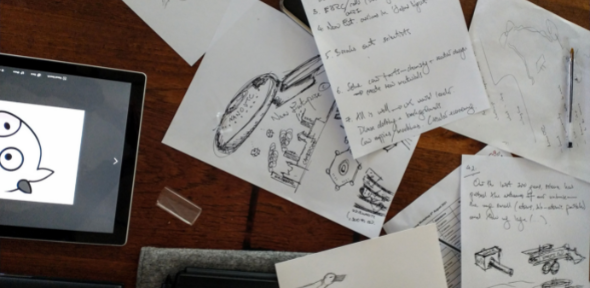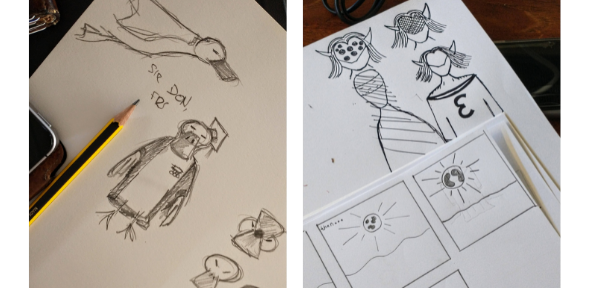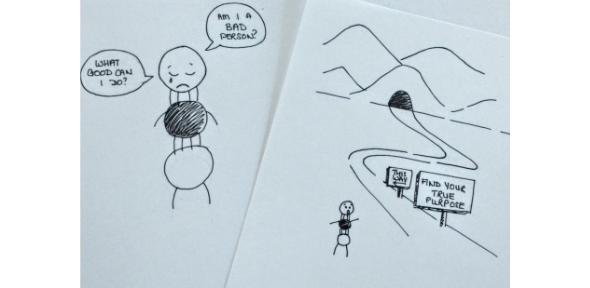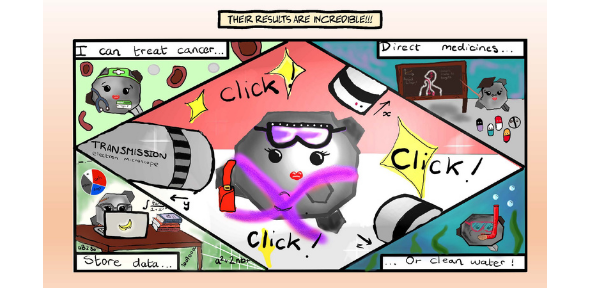
Between July and September, about 60 students from the CDT in Nanoscience and Nanotechnology (NanoDTC) took part in a Graphic Science lecture and workshop to explore how complex scientific ideas can be expressed through drawing.
I really enjoyed the process of turning a project into a compelling story, from learning more about my group’s research interests and bouncing ideas off each other to drawing lots and lots of tiny Tetris pieces! Robin Horton
With the help of local artist James Norton, the students looked at diagrams that changed the world before developing a comic strip that explored their individual research projects.
The UKRI CDT in Nanoscience and Nanotechnology (NanoDTC) is an interdisciplinary centre working to break silos between disciplines. Based across the departments of Physics, Chemistry, Materials and Engineering, it bridges ground-breaking fundamental science toward industrial device integration, and drives technological innovation via a strongly interdisciplinary approach. The centre trains high-calibre ‘T-shaped’ students in a wide array of topics in nanoscience, whilst developing in-depth expertise in a few specific areas, in addition to getting trained in innovation, systems integration and science communication.
“After a year on Zoom, we were keen to organise an in-person but computer-free event for our students,” said Nano DTC Deputy Director Karishma Jain. “The comics angle offered an exciting twist to our transferable skills training. We were very impressed by their creativity and their willingness to think outside-the-box. The results are truly remarkable and fun. Selecting the top four comics was extremely difficult!”
But a selection was made and we are pleased to share here the top four comics that came out of these two sessions. We've asked the groups to tell us about the artistic and creative process, and if the change of perspective made a difference to the way they think and talk about their own research.
Finding Maggie - Now in 3D!
By George Lewis, Mohammed Alawami, Tarig Mustafa, Ashleigh Ruane and Giovanni Oakes.
Discover in PDF or video format.
Tell us about your group and how you worked out the focus of your comics
Ours was the ‘quarantine group’ but all of us being stuck inside made the comic an enjoyable diversion! After hearing a bit about everyone’s project we settled on George’s magnetic imaging project as we thought it would be the easiest to create characters from the nanoparticles he works with.
What would you say was the most interesting aspect of this workshop?
The best part of the workshop was the fun we had creating this little alternative reality where journalists go round with their electron microscopes to try and snap images of flamboyant, celebrity, magnetic nanoparticles. It was really exciting seeing other people describe my research in ways I would never have imagined.
You were asked to think about your research in terms of storyline and characters, did that help you getting a new or different perspective on your research?
“This was certainly a perspective from which I had never considered my research before… ,” explained George. “It was great for me though because it forced me to distil the main aims of my project into simple language so that everyone in the team knew what we were aiming for, and so that the comic didn’t get too complicated.“
Sally the space solar cell
By Ryo Mizuta, Eduardo Camarillo-Abad, Aoife Gregg and Arvind Pujari.
Discover in PDF or video format.
Tell us about your group and how you worked out the focus of your comics
Our group collectively selected Eduardo’s PhD as the subject of our comic given its space-related theme and its potential to be easily framed in a sci-fi narrative. Before establishing the storyline, our group focused on creating the core characters by way of intense doodling; this naturally led to the conception of the protagonist: Sally the solar cell. With guidance from Eduardo on the science and James assisting on the storytelling, the team then created Sally’s journey to Europa and her encounters with the antagonists (the proton pirates).
The drawing and inking process was also collaborative, with Eduardo and Ryo leading the initial sketching, while Aoife and Arvind focused on inking the sketches into their final form.
What would you say was the most interesting aspect of this workshop?
One of the most interesting aspects was the process of creating the characters. We initially came up with the idea of space travel for our comic, but instead of having the scientists on board the spaceship as the main characters, Sally the solar cell emerged as a more fun and interesting character to focus on.
We naturally went for the problem (radiation damage to solar cells) and solution (ultra-thin solar cells) as the good and bad guys for the story. Another interesting and challenging aspect was trying to come up with good ways to explain very abstract scientific concepts with simple text and drawings.
You were asked to think about your research in terms of storyline and characters, did that help you getting a new or different perspective on your research?
“Thinking about my research as a story certainly helped me look at it from a different perspective”, said Eduardo. “It can be easy to get caught in the specific details of your research and sometimes you forget the importance of taking a step back and looking at its wider implications and the broader context in which your work can be impactful.
“I believe this context is essential for developing a compelling storyline, particularly one that is accessible to people not familiar with the field. Additionally, coming up with the story and characters required revisiting some of the key scientific concepts underpinning my research and some of the current limitations and challenges in the field.“
‘Beauty is in the eye of the bee-holder’
By Robin Horton, James Steele and Oliver Powell.
Discover in PDF or video format.
Tell us about your group and how you worked out the focus of your comics
We are three members of the 2021 cohort to the NanoDTC, who were in our first few days of the programme when we took part in the graphic science workshops. The closest in-depth research we had done was from previous Master's level projects, so we chose between us one with the best narrative and potential to create a visually appealing comic out of.
“It was the perfect icebreaker,” said James. “You don't realise how well you’re getting to know your cohort, whilst also being introduced to their backgrounds and interests.”
What would you say was the most interesting aspect of this workshop?
The most interesting aspect was having freedom to use different mediums for creating the comic. We used pencil drawing, watercolour and digital illustration, which added to the intended narrative.
“It was so much fun!” exulted Robin. “I really enjoyed the process of turning a project into a compelling story, from learning more about my group’s research interests and bouncing ideas off each other to drawing lots and lots of tiny Tetris pieces! I've learned a lot about how to communicate scientific ideas in new and accessible ways, and connected with my fellow course mates.”
You were asked to think about your research in terms of storyline and characters, did that help you getting a new or different perspective on your research?
Looking at the research from a different perspective was helpful, since it's often easy to miss the broader picture of the often niche and detailed research we undertake day-to-day. It's also easy to get lost in the process of long projects, losing sight of the goals of the work and the motivations for why it was started in the first place.
“Transforming a research project into a comic makes completely new topics (and people!) less intimidating,” explained James. “It imparts an appreciation of the difference a good story can make when communicating new ideas.”
Ion Transport Highway
By Alice Merryweather, Anna Scheeder, Alice Dearle, Joonatan Laulainen and Daniel Scott.
Discover in PDF or video format.
Tell us about your group and how you worked out the focus of your comics
The members of our group all work on different research projects, spanning a diverse variety of themes and backgrounds. After first individually considering our own projects and how they might be communicated by characters and stories, we came together to share our ideas and pick one story to turn into our comic. We were keen to select an option that allowed us to communicate a fundamental scientific concept, where an idea that would usually be quite abstract could be translated into an easy-to-visualise plot. We settled on the idea of representing ion-transport in battery electrode materials.
What would you say was the most interesting aspect of this workshop?
The workshop was a fun opportunity to discuss different and unusual ways of representing scientific research. The visual format of a comic is an interesting tool since it is widely appealing and accessible to many different audiences. It was also good fun and quite satisfying to produce the characters and drawings!
You were asked to think about your research in terms of storyline and characters, did that help you getting a new or different perspective on your research?
This workshop forced us to strip away the technical scientific vocabulary that we would usually use to communicate our work, and instead focus on simple and intuitive explanations which could be represented and understood pictorially. This required us to isolate only the most important concepts that we needed to include in our story, which is always helpful for communicating research.



